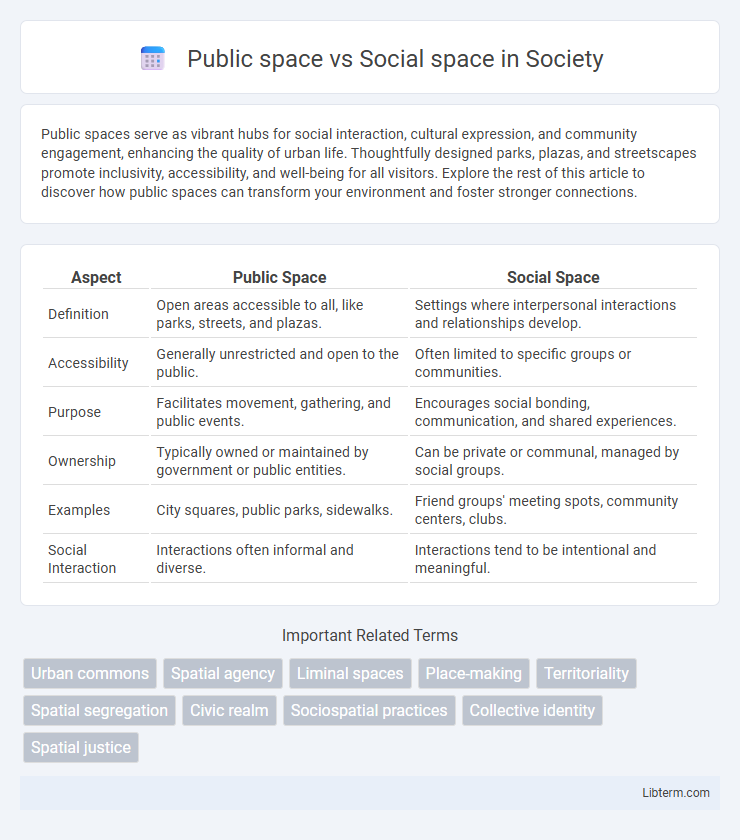Public spaces serve as vibrant hubs for social interaction, cultural expression, and community engagement, enhancing the quality of urban life. Thoughtfully designed parks, plazas, and streetscapes promote inclusivity, accessibility, and well-being for all visitors. Explore the rest of this article to discover how public spaces can transform your environment and foster stronger connections.
Table of Comparison
| Aspect | Public Space | Social Space |
|---|---|---|
| Definition | Open areas accessible to all, like parks, streets, and plazas. | Settings where interpersonal interactions and relationships develop. |
| Accessibility | Generally unrestricted and open to the public. | Often limited to specific groups or communities. |
| Purpose | Facilitates movement, gathering, and public events. | Encourages social bonding, communication, and shared experiences. |
| Ownership | Typically owned or maintained by government or public entities. | Can be private or communal, managed by social groups. |
| Examples | City squares, public parks, sidewalks. | Friend groups' meeting spots, community centers, clubs. |
| Social Interaction | Interactions often informal and diverse. | Interactions tend to be intentional and meaningful. |
Defining Public Space: Key Characteristics
Public space is characterized by its accessibility to all individuals without restriction, serving as a physical area where people can gather, interact, and engage in various activities. Key attributes include openness, neutrality, and a design that encourages social exchange, often encompassing parks, plazas, streets, and squares. These spaces foster community interaction by providing inclusive environments that support both spontaneous and organized social behaviors.
Understanding Social Space: Core Concepts
Social space refers to the dynamic environments where human interactions, relationships, and community bonds are actively formed and maintained, distinguished from public space by its emphasis on social connections rather than mere physical accessibility. Core concepts of social space include relational engagement, shared meanings, and mutual recognition among participants, which shape the social fabric and identity of the space. Understanding social space requires analyzing patterns of communication, cultural practices, and social networks that give the space its distinctive social character and functional purpose.
Historical Evolution of Public and Social Spaces
Public spaces have historically evolved from ancient agoras and Roman forums designed for civic engagement and commerce, while social spaces emerged as informal settings for community interaction and cultural exchange. The transformation continued through medieval marketplaces and Renaissance piazzas, reflecting shifts in urban planning and social norms. In contemporary society, the delineation between public and social spaces blurs as digital platforms and hybrid environments redefine communal interaction.
The Role of Accessibility in Space Differentiation
Accessibility plays a crucial role in differentiating public space from social space by determining who can enter and engage within each environment. Public spaces are typically designed for unrestricted access, promoting inclusivity and interaction among diverse populations. Social spaces, however, often have controlled accessibility, fostering intimate connections and tailored interactions among specific groups.
Ownership and Governance in Public vs Social Spaces
Public spaces are typically owned and managed by government entities, ensuring open access and regulatory oversight for the community. Social spaces, often privately owned or managed by organizations, emphasize controlled access and tailored governance to support specific social interactions or group needs. The contrasting ownership models directly influence the governance structures, access policies, and the degree of user participation in decision-making processes within each space.
Social Interaction and Community Dynamics
Social spaces foster direct social interaction and community dynamics by encouraging face-to-face communication, collaboration, and shared experiences. Public spaces, while accessible to all, often lack the intimate settings necessary for meaningful social exchanges, resulting in more transient and less cohesive community engagement. The design and management of social spaces prioritize inclusivity and participation, enhancing trust and collective identity within communities.
Cultural Significance and Symbolism
Public spaces serve as accessible venues where diverse communities engage in cultural rituals, festivals, and performances, embodying collective identity and societal values. Social spaces, often more intimate and localized, facilitate interpersonal connections and cultural exchange, reinforcing shared norms and group cohesion through symbolic interactions. The cultural significance of public spaces lies in their role as democratic arenas for expressing collective memory and identity, while social spaces symbolize personal and communal belonging within smaller social networks.
Challenges and Conflicts in Shared Spaces
Public spaces often face challenges of overcrowding, conflicting activities, and lack of privacy, making management and maintenance difficult. Social spaces, while designed for interaction, can encounter conflicts due to differing group norms, exclusivity, and competing uses within the same area. Balancing accessibility, safety, and inclusivity remains a critical issue in maintaining harmony in shared environments.
Urban Planning: Designing Inclusive Spaces
Urban planning prioritizes creating inclusive spaces by balancing public space, which is accessible to all individuals regardless of social group, with social space that fosters community interactions and a sense of belonging. Public spaces such as parks, plazas, and streets must be designed with accessibility, safety, and cultural diversity in mind to encourage equitable use and social cohesion. Integrating elements like seating, greenery, and flexible layouts transforms public areas into vibrant social spaces that promote inclusivity and civic engagement in urban environments.
Future Trends: Blurring Boundaries Between Public and Social Spaces
Future trends indicate a growing convergence between public and social spaces, driven by technology integration and shifting societal behaviors. Urban design increasingly incorporates hybrid environments that facilitate both community interaction and personal connection, enhancing inclusivity and flexibility. Smart city innovations and digital platforms enable seamless transitions between public gatherings and intimate social experiences, redefining spatial functionality.
Public space Infographic

 libterm.com
libterm.com